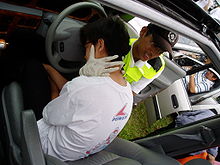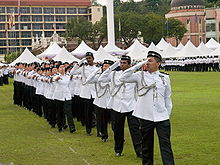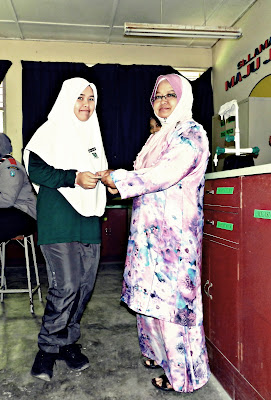St. John Ambulance of Malaysia (
Malay:
St. John Ambulans Malaysia,
Abbreviation:
SJAM) is a Malaysian-based, non-profit statutory body dedicated to the works of humanity and charity for the relief of persons in sickness, distress, suffering or danger without any distinction of race, class, colour or creed. With a history stretching back over a century, SJAM forms part of the wider
St. John Ambulance, a foundation of the
Venerable Order of Saint John with presence in 41 sovereign states, dependencies, autonomies or territories.
History
The history of St. John Ambulance in the present day
Malaysia started in 1908 with the formation of St. John Ambulance Association ("SJAA"); however, the movement was confined to the Army and the Railways till 1938. When the war clouds were gathering in 1938, the authorities decided to form the St. John Ambulance Brigade ("SJAB") in all larger states. Brigade members were first recruited as stretcher-bearers. Once they were proficient, they attended first aid lectures. In 1941, regular meetings and air raid practices were held.
[1]
In September 1941, the authorities introduced the Medical Auxiliary Service and all Brigade members were automatically drafted into this service. When the Japanese Forces raided the Malay Peninsular from 8 December 1941, the Brigade members did magnificent work in all the first aid posts. Many Brigade members withdrew to the south together with the British Forces as their towns were captured one after another by the Japanese Forces. Many more served in the Battle of Singapore and lost their lives for the Service of Mankind. St. John Ambulance was the only voluntary organisation in the Malay Peninsular that rendered medical services before and during the Second World War.
[1]
The return of the British after the end of the Second World War has resulted in the re-organisation of many institutions and that contributed to the expansion of SJAA and SJAB to all states by 1959.
In a move to further strengthen the operations of SJAA and SJAB, particularly after the independence of Malaya in 1957 and the subsequent merger between Malaya, Sabah and Sarawak (to form Malaysia) in 1963, the Government of Malaysia decided to amalgamate SJAA and SJAB in Malaya, Sabah and Sarawak into one Corporation known as the St. John Ambulance of Malaysia. This was made possible with the passing of the St. John Ambulance of Malaysia (Incorporation) Act, 1972 by the Federal Parliament. The Royal Assent was granted on 23 March 1972.
[
Membership
Membership in SJAM is open to all individuals of good characther, good physique and medically fit between 17 and 65 years of age. SJAM accepts suitable and interested individuals from all walks of life but passing the Basic First Aid examination is a pre-requisite before an individual is recognised of having attained the minimum competency to be a uniformed volunteer. First aid training and induction courses are provided to all prospective volunteers free of charge.
SJAM is led by volunteers appointed to functional roles. While all new volunteers would usually be admitted at the basic rank of Ambulance Member (male) or Nursing Member (female), a higher rank may be subsequently assigned, as appropriate, based on respective functional appointments to describe a formal grade within the organisation conferring authority.
Skills
Volunteers are provided with progressive training and re-training opportunities and can complete a number of first aid qualifications. Training for basic to intermediate skill sets are usually provided at Divisional-level, whereas training for additional and enhanced skills such as ambulance driving and handling, management of mass-casualty incidents, as well as the use of an automated external defibrillator ("AED") are centrally conducted by suitable qualified trainers at the State/Regional Headquarters or Area Headquarters.

Moulage - Motor Vehicle Accident
Healthcare Professionals
Whilst the majority of volunteers in SJAM are non-healthcare professionals, SJAM welcomes the involvement of healthcare professionals such as Medical Practitioners, Paramedics, Nurses and Medical Assistants to volunteer. Unlike the rest, healthcare professionals do not require to demonstrate their competency through attaining first aid certificates, but their qualifications and professional status are checked with the appropriate regulatory body before admission to SJAM. Healthcare professionals are required for tasks appropriate to their technical competencies during operational duties, as well as training for other volunteers in certain enhanced skills.
Developing Human Capital
Suitably experienced volunteers, upon demonstrating outstanding competency in Advanced First Aid, may be chosen to be developed as First Aid Trainers. Chosen candidates will undergo development, exposure and assessment in methodology of training before being accredited as First Aid Trainers. Volunteers with such accreditation are entrusted to facilitate training and re-training activities for other volunteers, as well as first aid courses for the public.
Relevant training activities targeting on management, administration and leadership are also provided to volunteers appointed to functional roles. Many volunteers argued that their experience in SJAM, coupled with such exposures, have somewhat given an edge to their career.
Rank Insignia
Officers
-
-
Deputy National President
-
Deputy Commander-in-Chief
-
Hon. Secretary-General
Chief Superintendent
Regional/State Commander
Principal Staff Officer
Deputy Regional/State Commander
Staff Officer Grade I
Regional/State Superintendent
Area Commander
Staff Officer Grade II
Area Superintendent
-
Staff Officer Grade IV
Divisional Superintendent
Staff Officer Grade V
Divisional Officer
Staff Officer Grade VI
Acting Divisional Officer
Other Ranks
-
Regional/State Sergeant-Major
-
-
-
-
-
-
Ambulance Member
Nursing Member
SJAM Uniform
With traditions and customs inherited from the SJAB, SJAM is somewhat paramilitary in its protocol and image and hence, SJAM volunteers is recognisable by its distinct white-and-black uniform. Volunteers are required to wear uniform to provide services, both for identification and to present a professional image. Unlike the uniform of other volunteer organisations in Malaysia, SJAM uniform is protected by the law, and may only be worn by volunteers who have been certified to have at least the minimum competency to be a uniformed personnel.

Officers in Uniform No. 1 during a ceremonial parade
There are presently three orders of dress intended for different situations, as follows:
- Uniform No. 1: Ceremonial Uniform, an elaborate uniform worn during ceremonial occasions only.
- Uniform No. 2: Duty Uniform, a basic operational uniform suitable for all types of duties, as well as parades and formations.
- Uniform No. 3: Mess Dress, an evening dress worn at formal occasions.
Uniform No. 2 is the most widely used among the three. Yellow/green two-tone high visibility garments are sometimes worn over Uniform No. 2 for outdoor events for safety and ease of identification. For Officers, there are two variants of Uniform No. 2. Beret is worn during operational duties only, whereas Peaked Cap (male) or Bowler's Hat (female) are used in Uniform No. 2 in events other than operational duties.
For training and informal events, Training Order (consisting white SJAM polo T-shirt and black trousers similar to Uniform No. 2) is worn. On rare occasions (subject to waiver instructions), Training Order is also used for operational duties, but it is usually invoked during disasters which requires rapid mobilisation and deployment of volunteers, or when long hours of stand-by is required or expected.














.jpg)




+of+BLOGGER+HEAD.png)






























